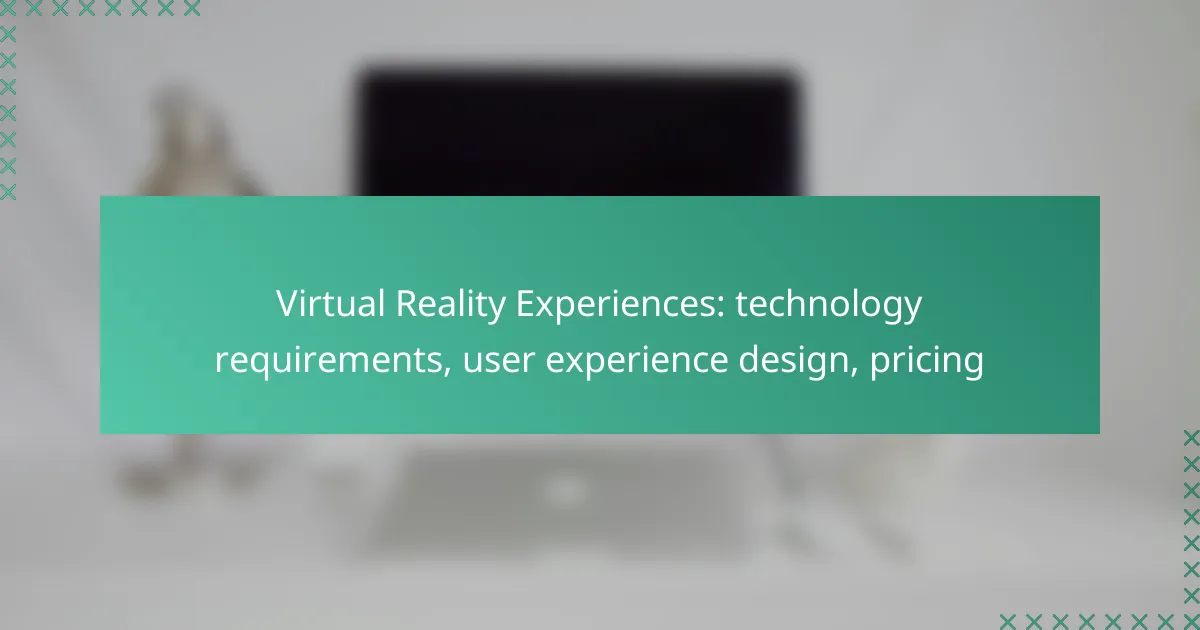Virtual reality experiences require specific technology, including high-performance headsets and powerful gaming PCs, to ensure an immersive experience. Effective user experience design focuses on creating engaging environments that cater to user needs and facilitate intuitive interactions. Additionally, pricing for VR experiences can vary significantly, encompassing initial hardware investments and ongoing software costs.
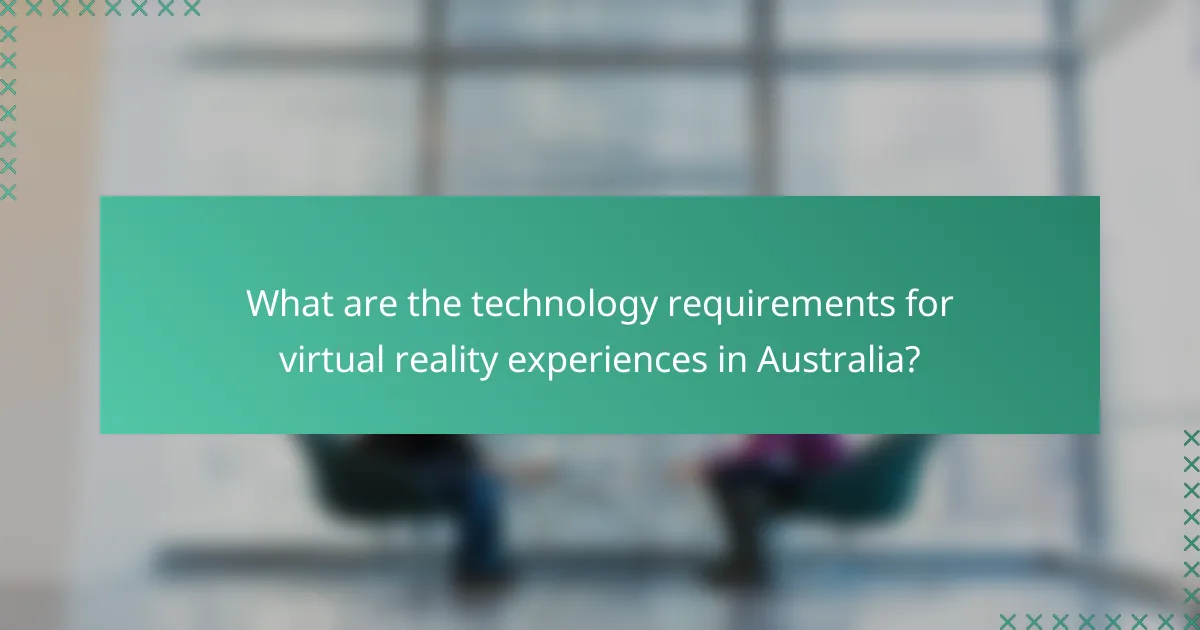
What are the technology requirements for virtual reality experiences in Australia?
To enjoy virtual reality experiences in Australia, users need specific technology that includes high-performance VR headsets, powerful gaming PCs, compatible software platforms, adequate internet bandwidth, and motion tracking devices. Meeting these requirements ensures an immersive and smooth VR experience.
High-performance VR headsets
High-performance VR headsets are essential for an immersive experience, offering high resolution and wide field of view. Popular models such as the Oculus Quest 2 and HTC Vive Pro provide excellent visuals and comfort, but they require a significant investment, often ranging from AUD 500 to AUD 1,500.
When selecting a headset, consider factors like refresh rate, tracking technology, and compatibility with your existing hardware. Ensure that the headset supports the content you wish to access, whether it’s gaming, educational, or social VR experiences.
Powerful gaming PCs
A powerful gaming PC is crucial for running VR applications smoothly. Look for systems equipped with high-end graphics cards, such as NVIDIA GeForce RTX 3060 or better, along with at least 16GB of RAM and a fast processor, like an Intel i7 or AMD Ryzen 7.
Building or purchasing a gaming PC can cost anywhere from AUD 1,000 to AUD 3,000, depending on the specifications. Ensure that your PC meets the minimum requirements of the VR headset and the software you plan to use for optimal performance.
Compatible software platforms
Compatible software platforms are necessary to access VR content. Popular platforms include SteamVR, Oculus Store, and PlayStation VR, each offering a variety of games and experiences. Make sure your headset is compatible with the chosen platform to avoid issues.
Check for software updates regularly to enhance performance and access new features. Some platforms may require subscriptions or one-time purchases for specific content, so factor these costs into your budget.
Internet bandwidth specifications
Reliable internet bandwidth is important for online VR experiences, especially for multiplayer games or streaming content. A minimum download speed of 25 Mbps is recommended for a smooth experience, while upload speeds should be at least 5 Mbps.
Consider using a wired connection for stability, as Wi-Fi can introduce latency. If you plan to use cloud-based VR services, ensure your internet plan can handle the data requirements without throttling.
Motion tracking devices
Motion tracking devices enhance the VR experience by allowing users to interact with the virtual environment. Many high-end headsets come with built-in tracking, but additional devices like the HTC Vive Base Stations or Oculus Touch controllers can improve accuracy.
When setting up motion tracking, ensure your play area is clear of obstacles and large enough to allow for movement. Proper calibration is crucial for an immersive experience, so follow the manufacturer’s instructions carefully.
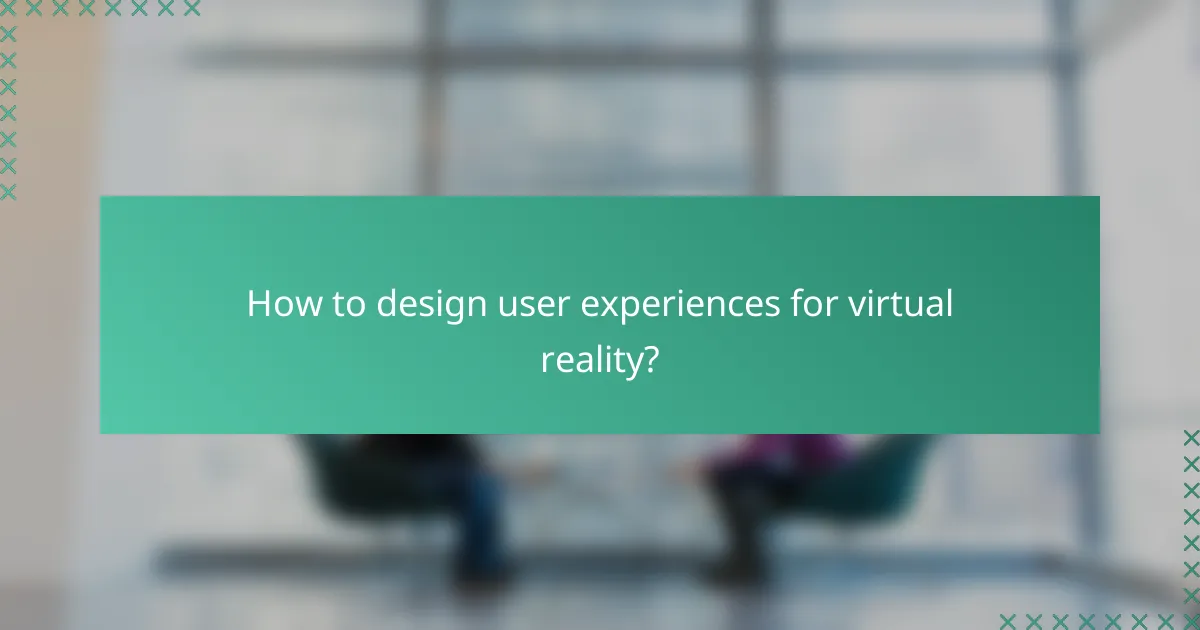
How to design user experiences for virtual reality?
Designing user experiences for virtual reality (VR) involves creating immersive environments that engage users effectively. Key considerations include understanding user needs, leveraging technology, and ensuring intuitive interactions.
User-centered design principles
User-centered design (UCD) focuses on the needs, preferences, and limitations of end-users throughout the development process. This approach ensures that VR experiences are tailored to provide maximum engagement and satisfaction. Start by conducting user research to gather insights on target audiences, which can guide design decisions.
Incorporate feedback loops during the design phase, allowing users to test prototypes and provide input. This iterative process helps identify usability issues early and refine the experience based on real user interactions.
Immersive storytelling techniques
Immersive storytelling in VR captivates users by placing them at the center of the narrative. Techniques such as spatial audio, interactive elements, and environmental storytelling enhance the sense of presence. For example, using 3D sound can make users feel as though they are part of the scene, reacting to their movements and choices.
Consider using branching narratives that allow users to make decisions affecting the storyline. This interactivity not only increases engagement but also fosters a deeper emotional connection to the experience.
Usability testing methods
Usability testing is crucial for evaluating how effectively users can navigate and interact within a VR environment. Methods such as observational studies, think-aloud protocols, and task completion rates can provide valuable insights. Aim for a diverse group of testers to ensure a comprehensive understanding of usability across different demographics.
Utilize metrics like time on task and error rates to identify areas for improvement. Conducting usability tests iteratively throughout the development process allows for ongoing refinement and enhances the overall user experience.
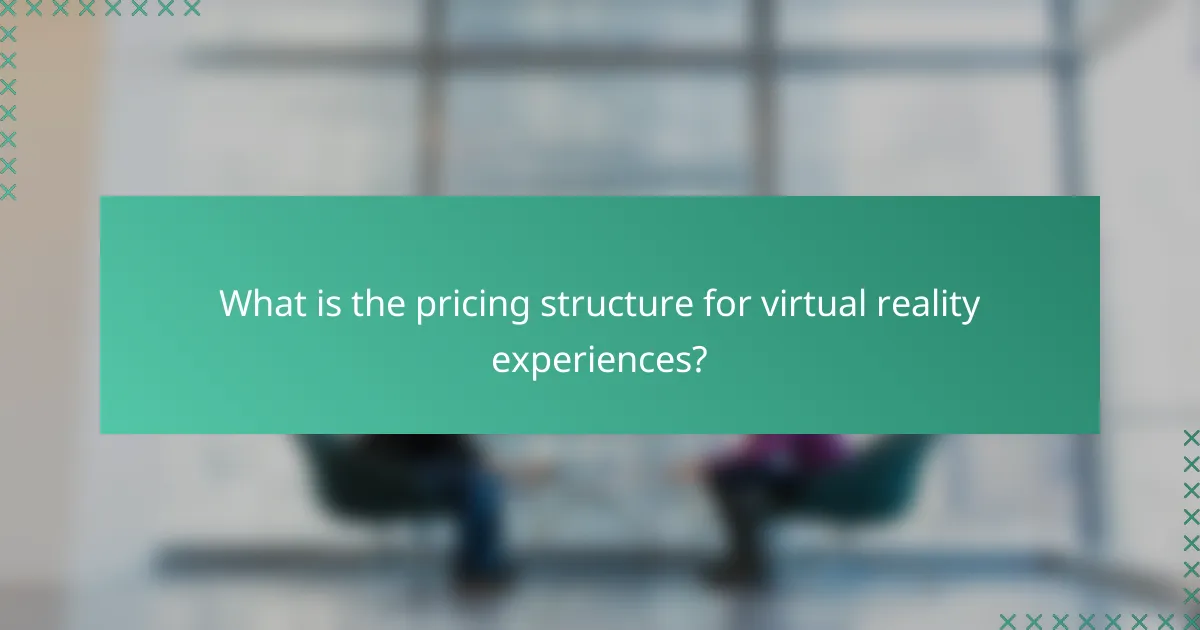
What is the pricing structure for virtual reality experiences?
The pricing structure for virtual reality (VR) experiences varies widely based on hardware, development, and content delivery methods. Users can expect to invest in both initial hardware and ongoing costs for software and content access.
Cost of VR hardware
The cost of VR hardware can range from a few hundred to several thousand dollars, depending on the quality and capabilities of the equipment. Entry-level headsets may start around $300, while high-end systems can exceed $1,000. Additionally, consider the need for compatible computers or consoles, which can add to the overall expense.
When selecting VR hardware, assess your intended use. For casual gaming, a standalone headset may suffice, while professional applications often require more advanced setups with external sensors and higher processing power.
Development costs for VR applications
Development costs for VR applications can vary significantly based on complexity and functionality. Simple applications might cost tens of thousands of dollars, while more intricate experiences can reach hundreds of thousands. Factors influencing costs include design, programming, and testing phases.
For businesses looking to develop VR content, it’s crucial to outline clear objectives and budget accordingly. Collaborating with experienced developers can help streamline the process and avoid unexpected expenses.
Subscription models for VR content
Subscription models for VR content typically range from $10 to $30 per month, offering access to a library of experiences. These models can provide a cost-effective way to explore various VR applications without committing to individual purchases.
When considering subscriptions, evaluate the content library and whether it aligns with your interests. Some platforms may offer free trials, allowing users to test the service before making a financial commitment.
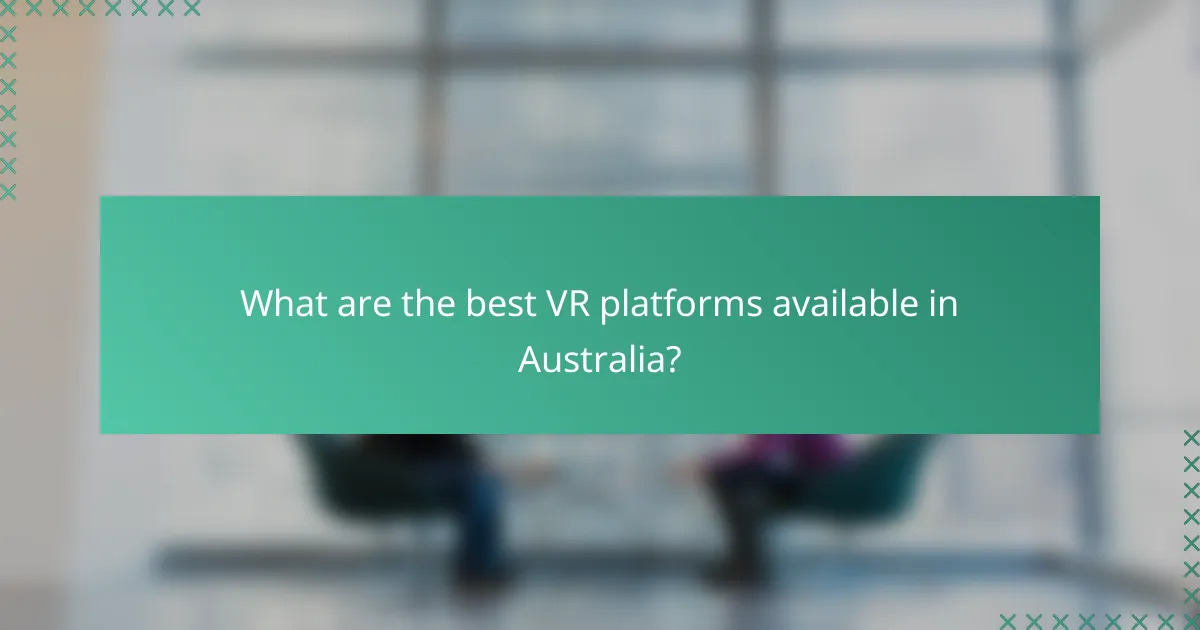
What are the best VR platforms available in Australia?
The best VR platforms in Australia include Oculus Quest 2, HTC Vive Pro 2, and PlayStation VR. Each platform offers unique features, performance levels, and pricing, catering to different user needs and preferences.
Oculus Quest 2
The Oculus Quest 2 is a standalone VR headset that does not require a PC or console, making it highly accessible. It features a resolution of 1832 x 1920 per eye and offers a wide range of games and experiences.
Consider its wireless capabilities and ease of use, which are ideal for casual users. However, for more demanding applications, users may find the performance limited compared to PC-tethered systems.
HTC Vive Pro 2
The HTC Vive Pro 2 is designed for high-end VR experiences, featuring a resolution of 2448 x 2448 per eye and a wider field of view. This platform is best suited for users who prioritize visual fidelity and immersive experiences.
It requires a powerful gaming PC to operate, which can increase overall costs. Additionally, the setup process is more complex, making it less user-friendly for beginners.
PlayStation VR
PlayStation VR is a popular choice for console gamers, compatible with PlayStation 4 and PlayStation 5. It offers a solid library of exclusive games and experiences, making it appealing for those already invested in the PlayStation ecosystem.
While its resolution of 1920 x 1080 is lower than some competitors, it remains a cost-effective option for gamers. Users should consider the need for a PlayStation console, which adds to the overall investment.
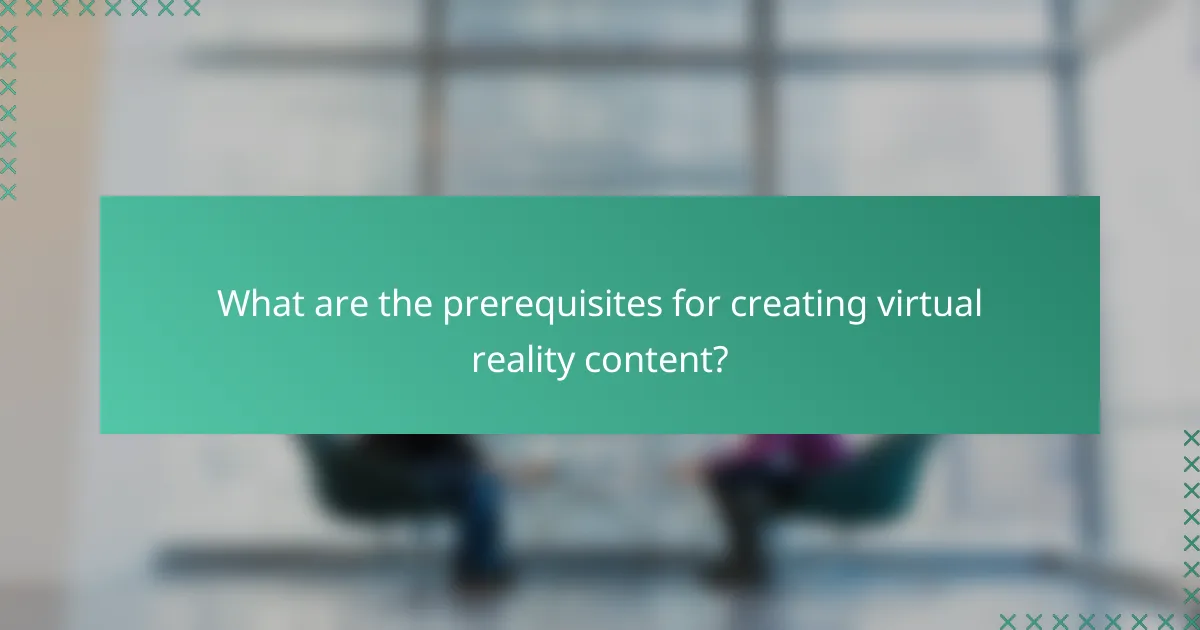
What are the prerequisites for creating virtual reality content?
Creating virtual reality (VR) content requires a combination of technical skills, software tools, and an understanding of user experience design. These prerequisites ensure that developers can produce immersive and engaging VR experiences that meet user expectations.
Technical skills required
Developers need a solid foundation in programming languages such as C# or C++, which are commonly used in VR development. Familiarity with 3D modeling and animation software, like Blender or Maya, is also essential for creating realistic environments and characters.
Additionally, understanding concepts related to game design, physics, and user interface design is crucial. This knowledge helps in crafting intuitive interactions and ensuring that the VR experience is both engaging and functional.
Software tools for VR development
Several software tools are popular for VR content creation, with Unity and Unreal Engine being the most widely used. Both platforms offer robust features for building immersive environments and support various VR hardware.
Other tools include A-Frame for web-based VR, and Blender for 3D modeling. Developers should choose tools based on their project requirements, budget, and the specific VR hardware they intend to target.
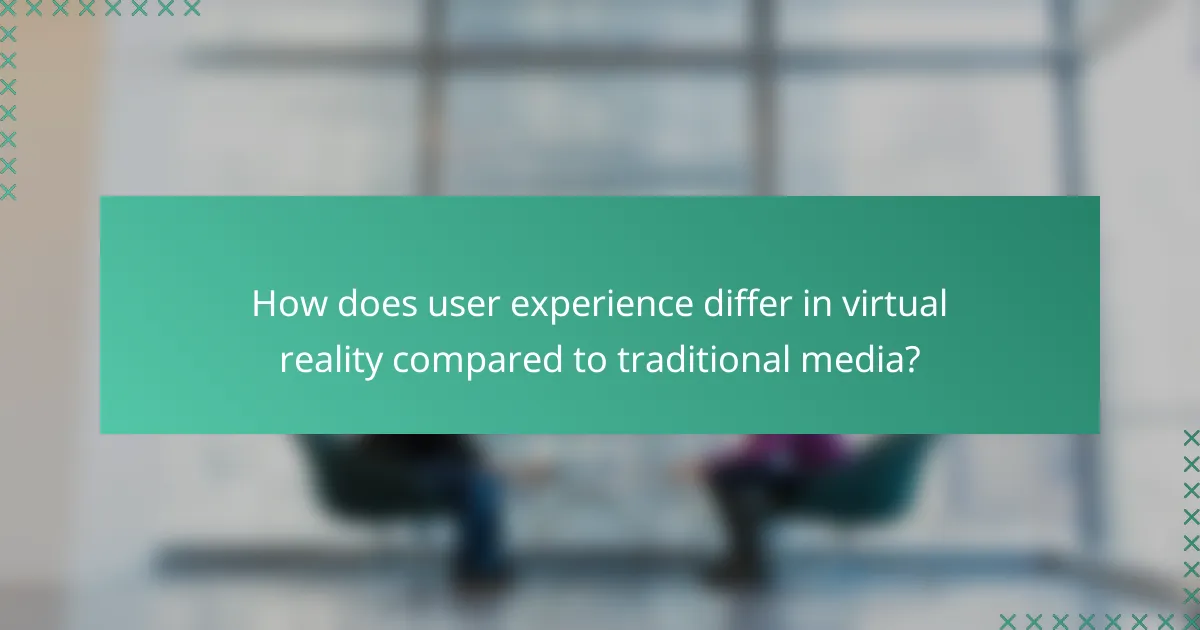
How does user experience differ in virtual reality compared to traditional media?
User experience in virtual reality (VR) is immersive and interactive, contrasting sharply with the passive nature of traditional media. In VR, users engage with a 3D environment, allowing for a sense of presence and agency that enhances emotional and cognitive responses.
Technology Requirements
To experience virtual reality, users need specific hardware and software. Essential components include a VR headset, which can range from standalone devices to those requiring a powerful PC, and motion controllers for interaction. Additionally, a suitable space is necessary to move freely and safely.
Common VR headsets include the Oculus Quest series, HTC Vive, and PlayStation VR. Users should also ensure their computers meet recommended specifications, typically involving a high-end graphics card, sufficient RAM, and a fast processor to handle VR applications effectively.
User Experience Design
User experience design in VR focuses on creating intuitive and engaging environments. Designers must consider factors such as spatial awareness, user comfort, and interaction methods. Effective VR experiences often utilize familiar gestures and visual cues to guide users.
Designers should prioritize minimizing motion sickness by maintaining a stable frame rate and avoiding rapid movements. Testing with real users is crucial to refine the experience and ensure it meets the needs of the target audience, whether for gaming, training, or social interaction.
Pricing
The pricing for virtual reality experiences varies widely based on hardware, software, and content. Entry-level VR headsets can start around a few hundred dollars, while high-end systems may exceed a thousand dollars. Software costs can range from free applications to premium games and experiences priced at $30 or more.
When budgeting for VR, consider ongoing costs such as game purchases, subscription services, and potential upgrades to hardware. For businesses looking to implement VR, investment in development and training can also be significant, but the potential for enhanced engagement and training effectiveness may justify the expense.
